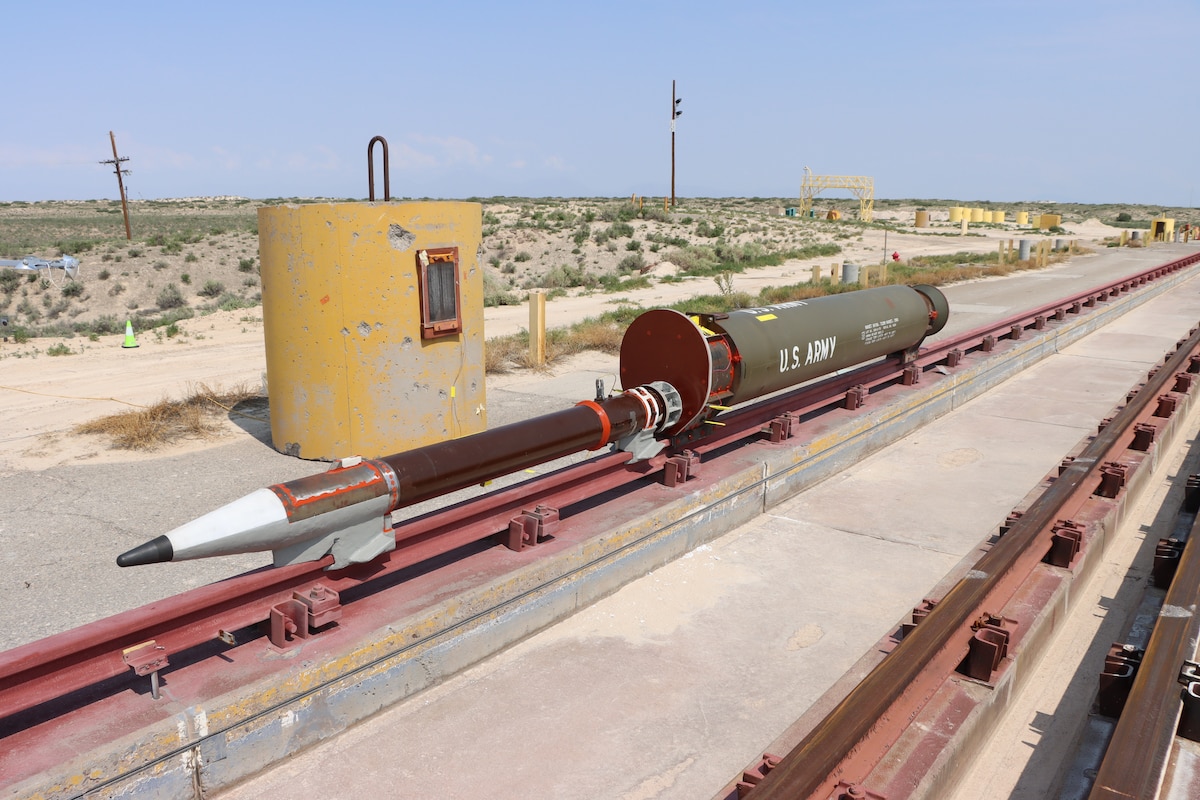The US Air Force’s (USAF’s) 846th Test Squadron at Holloman Air Force Base, New Mexico, announced on June 2 that it was able to successfully recover a reusable rocket sled after traveling at a recorded speed of 6,400 feet per second (7022.6 kmph), or just about Mach 5.8 — beyond the hypersonic threshold, during a test in late March 2022.
The reusable rocket sled will provide critical data for hypersonic weapons development, said the USAF. A rocket sled is a test platform that slides along a set of rails propelled by rockets.

During Cold War, the US and the Soviet Union were engaged in a space race where they vied to develop rocket technology. Now, to realize space travel, rockets are tested for effects on the human body and these tests need to be conducted with rocket systems that have to be fired without losing control of the test platform.
This is where the rail system comes in, as it allowed the test platform to slide along the rails, thereby preventing loss of control.
Holloman High-Speed Test Track (HHSTT)
The Holloman Air Force Base (AFB) in New Mexico houses 59,971 feet long aerospace ground test facility — the longest facility of its type in the world — known as the Holloman High-Speed Test Track (HHSTT) which was first developed in 1947.
The facility provides a platform to test rocket systems, collect data and solve problems that cannot be completed by other means on the ground.
An essential benefit of using a free-floating sled attached to a long test track is that the test platform could be recovered after testing for post-run analysis.
There have been significantly higher speeds recorded at the HHSTT during rocket sled testing. In September 2019, a rocket sled achieved a speed of around Mach 8.6 or 10,619 kmph; however, the test in March 2022 was the highest speed a reusable rocket sled has reached before being successfully recovered.
The HHSTT is the only track capable of recovering sleds that hit hypersonic velocity – speeds of Mach 5 and above – by stopping them via high-speed braking.
Despite this, the majority of tests performed with sleds at the HHSTT, to date, have focused on ‘non-recovered impact testing,’ according to HHSTT project manager Daniel Lopez.
The last time, sleds traveling at hypersonic velocity were stopped, was in the summer of 2021, when two sleds traveling over 5,000-feet per second (5486.4 kmph) were recovered. Before that, nearly two decades had passed since recovered hypersonic missions had been conducted there.

“What you accomplished marked the fastest recovery of a monorail sled in over 30 years and the first time we have recovered a planned reusable sled at those speeds ever,” said Lt. Col. Paul Dolce, Commander of the 846th Test Squadron, while congratulating his team.
Hypersonic Sled Recovery (HSR)
Recovering reusable sleds traveling at hypersonic velocity is important for the 846th Test Squadron’s Hypersonic Sled Recovery (HSR) effort. It allows for the collection of critical data after testing is completed, which is particularly essential for hypersonic weapons testing.
“The HSR is a capability development effort being undertaken by the 846th to prepare for the increased need for hypersonic tests and evaluation in support of the National Defense Strategy,” HHSTT project manager Daniel Lopez had previously said.
“The project will continue to expand the braking capabilities to recover sleds from Mach 6-plus,” Loped added.

In addition to recovery missions, the 846th Test Squadron also provides relevant test data to verify lethality effects, impact survivability, aerothermal and weather effects, separation dynamics, guidance system performance, sensor performance, and other key performance metrics.
Hypersonic weapons testing is one of the US military’s top priorities and it places extreme stress on test subjects to determine which materials can withstand the heat and strain of sustained flight at speeds of Mach 5 and above.
This is an important part of studying the limits of a weapon’s flight performance and survivability before moving on to more expensive and complicated flight tests.
US Lags Behind In Hypersonic Weapons Race
Of late, the US is under increasing pressure due to the hypersonic threat from China and Russia, the only two countries having operational hypersonic weapons.
Last month the US conducted a successful test of an Air-launched Rapid Response Weapon (ARRW) hypersonic missile a few days after it had successfully tested its Hypersonic Air-Breathing Weapon Concept (HAWC). While the efforts in the US are ongoing, it could be some time before a weapon becomes operational.

Meanwhile, China has been achieving breakthroughs, such as in July of last year when it conducted a hypersonic test in which the missile went around the world at five times the speed of sound or Mach 5 and narrowly missed the target. Furthermore, the missile also fired a hypersonic glide vehicle (HGV), sparking widespread concern and panic among the US military brass.
In addition to offensive capabilities, Beijing is also making rapid progress in defensive systems against hypersonic missiles.
As EurAsian Times reported recently, Chinese military researchers claimed to have developed Artificial Intelligence (AI) technology that can predict the trajectory of a hypersonic glide vehicle as it approaches a target at speeds exceeding Mach 5.
How the #US faces catastrophic defeat by #China or #Russia in a hypersonic Third World War
US is lagging in the 'hypersonic race' as rival superpowers develop game-changing weapons including AI 'drone swarms' and autonomous rocketshttps://t.co/FjwdZJ6lEz
— Indo-Pacific News – Watching the CCP-China Threat (@IndoPac_Info) October 22, 2021
According to the researchers, a Chinese AI-powered air defense system can predict the potential kill trajectory of an incoming weapon and launch a swift counterattack with a three-minute advance time.
The US is also working on its Glide Phase Interceptor (GPI) program, designed to eliminate hypersonic missiles. However, the head of the US Missile Defense Agency (MDA) recently said that the interceptor system might not be ready even in the next decade.
- Contact the author at tanmaykadam700@gmail.com
- Follow EurAsian Times on Google News




